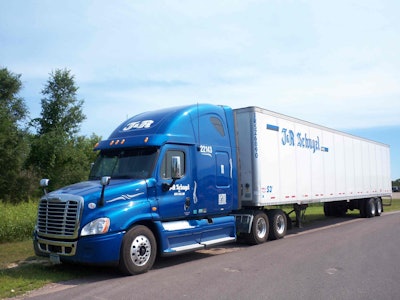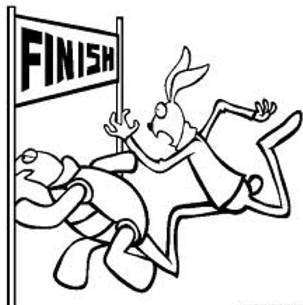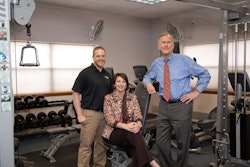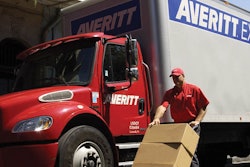 The carrier creates ‘Slower is Faster’ driver coaching to improve safety performance and increase productivity and fuel economy.
The carrier creates ‘Slower is Faster’ driver coaching to improve safety performance and increase productivity and fuel economy.As the trucking industry began to climb out of the recession in 2010, carriers were scrambling to find a competitive advantage over their peers. With the dawn of the Federal Motor Carrier Safety Administration’s Compliance Safety Accountability program, carriers searching for efficiency gains also were tasked with improving their safety performance.
In 2009, Minnesota became a pilot state for the CSA program, and J&R Schugel Trucking – a 600-truck refrigerated and dry van carrier based in New Ulm, Minn. – began to take a closer look at new procedures it could implement to improve its safety scores.
The 3-mph rule
By mid-2011, not only were accidents a concern, J&R Schugel also was facing challenges with driver satisfaction at a time when the industry-wide driver shortage was rearing its head. Company executives knew that being seen as a driver-friendly fleet was crucial to its growth and future success.
J&R Schugel operates its trucks with speed governors set to 65 mph. When the company instituted a new guideline in 2011 that asked drivers to go no faster than 62 mph, naturally it was met with skepticism.
From a safety standpoint, the difference between driving 65 mph and 62 mph can be huge, says Clay Merches, J&R Schugel’s vice president of safety and human resources. A truck traveling at 65 mph equates to 95.33 feet per second; at 62 mph, the truck is traveling almost 5 feet per second slower. “That doesn’t sound like a lot, but it could be the difference in stopping short of a rear-end collision,” says Merches.
During the rollout, Merches laid out how slower speeds affect drivers. Over the course of 11 drivable hours per day, the maximum time loss is roughly 33 minutes. But, as Merches points out, J&R Schugel’s drivers average less than 7.5 hours of driving per day, and on average only three hours per day are spent in 65-mph zones, equating to a maximum potential time loss of only nine minutes.
“I ask them, ‘Can you give me nine minutes?’ ” Merches says. “They see that it’s not that big a difference, and that’s how we create the buy-in.”
While the impact on drivers is minimal, the effect on J&R Schugel’s safety performance has proven dramatic. Rear-end collisions dropped 53 percent from 2011 to 2013, with only one in 2012. And because drivers were changing lanes about 30 percent less at 62 mph rather than 65 mph, lane-change collisions dropped from 25 to only seven in the same time period.
J&R Schugel’s CSA scores reflect the results of its 3-mph slower initiative. In 2010, the company had a Crash Indicator Behavior Analysis and Safety Improvement Category (BASIC) score of 97 percent; in December 2013, it was only 7.1 percent. Also, unsafe driving violations dropped from 286 to 180.
For its safety improvement, J&R Schugel was recognized by the Truckload Carriers Association as a division winner in the organization’s 2013 National Fleet Safety Awards program.
Getting there faster
Company executives quickly realized that even though the speed reduction program initially was created to improve safety performance, it also could help improve productivity.
To help drivers understand the importance of going 3 mph slower in 65-mph zones and its effect on productivity and fuel economy, J&R Schugel developed its “Slower is Faster” class, which it teaches to new drivers at orientation and as part of its continuous driver coaching courses.
 With its “slower is faster” approach, J&R Schugel’s trucks stay in top gear an average of 21 percent more often, resulting in a faster overall road speed.
With its “slower is faster” approach, J&R Schugel’s trucks stay in top gear an average of 21 percent more often, resulting in a faster overall road speed.According to Merches, drivers who follow the 3-mph speed reduction rule actually deliver loads faster than those who don’t follow the guideline. Merches says vehicle dynamics play a big role in this counterintuitive concept.
“We have our speed governors set at 65 mph, but when we drive at 62 mph, it allows the engine to continually get power and stay in top gear because the governor isn’t kicking in,” he says. “The driver isn’t losing momentum as he drives up an incline. A truck that weighs 80,000 pounds traveling at the 65-mph max speed slows down as it ascends a hill and has the governor kick out the fuel at the worst time – at the bottom of a hill.”
Initially, drivers naturally were hesitant to believe that driving slower could lead to greater overall road speeds. To prove the point, J&R Schugel performed a case study where one driver traveled at 65 mph as much as he could while another driver maintained a 60-mph maximum speed. The slower driver drove 28 miles further in 25 fewer minutes over the course of the daylong test. “Suddenly, the potential nine-minute loss is right out the window, and drivers buy into the concept,” says Merches.
“With the performance-monitoring capabilities we have now, we can break it down and show them,” says Merches, who challenges drivers who don’t believe the results to test it for themselves and come back to him with data to substantiate their beliefs. In three years, he hasn’t had a driver come back and say the program is wrong.
With its “slower is faster” approach, J&R Schugel’s trucks stay in top gear an average of 21 percent more often, resulting in a faster overall road speed. Before the company instituted the program, the fleet’s average road speed was 53 mph; today, the average is up to 57 mph. “Our operations staff is blown away that loads are actually being delivered quicker,” says Merches.
Beyond productivity gains, J&R Schugel also has been able to improve fuel economy dramatically as a result of the “slower is faster” approach. It now coaches drivers on the importance of cruise control, progressive shifting patterns and starting from stop in first gear.
J&R Schugel also monitors driver fuel performance regularly. Last summer, the fleet averaged 7.68 mpg – including local, regional and long-haul routes – up from 6.52 mpg before it rolled out the “slower is faster” program.
“I actually get drivers who pull up their fuel performance in the cab and send me a text message with a picture of their trip,” says Merches. “It’s fun to see the driver reaction and how they get involved and buy into the concept.”
Every month, J&R Schugel pulls the fuel mileage data for every truck and driver in its fleet. Those drivers in the bottom 10 percent of fuel economy performance undergo one-on-one coaching sessions on how they can work to improve fuel efficiency.
“This year, we would like our overall average fuel economy to be nearing 8 mpg,” says Merches. “Trying to get a driver who’s only getting 6.3 mpg up to 7 mpg or more is going to have a huge impact on raising the fleet average.”
The next step
Continuing its march toward even better safety performance and driver productivity, J&R Schugel is joining a growing list of carriers employing in-cab video. Last month, it announced it would begin installing driver- and road-facing cameras in all of its trucks for driver coaching and to lower accident frequency.
“We anticipate that we will have fewer hard-braking incidents, that drivers will look farther out in front of the vehicle, and that they will progressively downshift more frequently,” says Merches. “They don’t want to trigger the camera, so they’ll drive smarter and smoother.”
The company expects some initial blowback from its drivers but expects it to be short-lived. “When you put new technology in trucks, you have to teach the driver the reasons for it and how it will benefit them,” says Merches.











